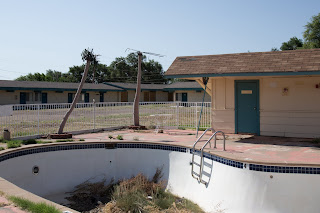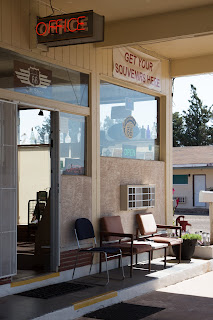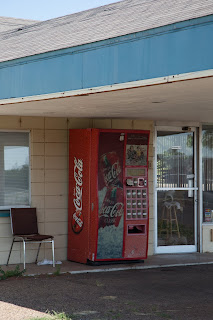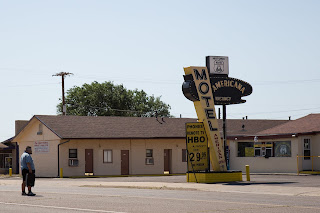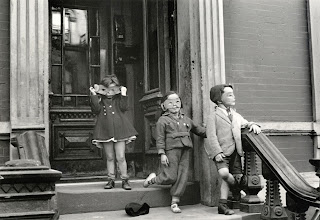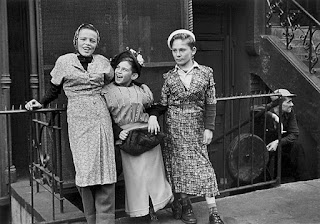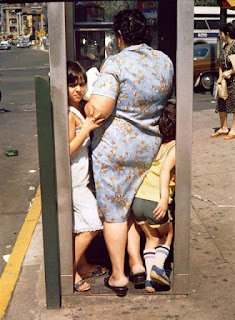In practicing photography, I have found an interesting dynamic between its practical side and its artistic side. Don't get me wrong, I love taking photographs with my iPhone, and, in fact, I often take the same photograph on both my phone and on my camera. This is generally for one of four reasons: I want it documented in color, I want the photograph in that moment, I want a future location and time reference, or just general anxiety over not developing the roll of film correctly and being devastated that photo will be lost forever.
The above photographs were taken within moments of each other at 42 Rue Notre-Dame de Lorette, Paris, France, at 10:23am on March 21. We can thank the metadata from the above photograph on the left for that information. In the moment, I took that photograph on my iPhone to capture the colors, and then experience a slight panic on the streets of Paris regarding the possibility that my film could have gone through too many x-ray machines and that everything would be ruined (despite the fact that I knew my ISO was low enough to survive the x-rays).
And in that moment, I thought that this photograph would be the best thing I captured all trip. Being a token member of Gen Z, I posted the photo to the left on my Instagram Story that evening. I haven't thought about it much since, except for with anticipation upon taking the freshly developed film off of the reel and placing it into the drying rack a few days upon returning home from Europe. Despite knowing this photograph would be far from one of the better photographs I took while in Paris, I still took the twenty minutes or so to make a test print of the photograph, and pinned it on the wall during one of our class critiques. In my defense of this photograph, I brought up the notion that it felt very Stephen Shore American Surfaces-like, and showed my professor the picture I shot on iPhone. Why yes, it felt reminiscent of Shore due to the colors that weren't captured with my Ilford HP5 black and white film, and the photograph was placed aside.
I ended up placing two photographs from Paris into my final portfolio, pictured below. The one on the left was taken on a busy shopping street in Paris, the right from Luxembourg Gardens. While you can disregard the discoloration of these two photos as they're scans of prints I made in the dark room, we will never see these photographs in color, as there was no iPhone documentation of these moments. In fact, there are only a few photos on my phone from moments surrounding these photographs at all. They were both taken in the afternoon. If we look closely at the right photo, perhaps we will find some indication of the day the photograph was taken. The left photo is somewhat indicative of the state of current affairs. Otherwise, these photos are relatively free from specifics.
In preparation for my summer internship, I read Brand Thinking and Other Noble Pursuits by Debbie Millman in May. Coined as "a series of illuminating and spirited conversations on branding with twenty-two of the world's top design executives, strategists, and critics", I consumed the book while noting various tips and advice from the likes of Malcolm Gladwell, Wally Olins, and Brian Collins. While it was an enjoyable book with a gold mine of information, there was one thing that irked me: if I were to read this book in the future, even just a couple of years into the future, it would be completely outdated. The specifics, if you will, in this book are terribly time-sensitive. Even in reading the book just a year or two after a new edition was published, I felt like there were a few questionable statements that were documented.
And yes, I know that is how time works. Things come and things go, and in the world we live in now, we can't even seem to remember what was popular, or "went viral", a month ago. It was that moment that I realized why I have become so enamored with the world of photography: my iPhone photos that live somewhere between the phone sitting on my kitchen table and the infamous "cloud" that is tossed around in conversation will eventually be lost. It is only a matter of time that the clarity and metadata captured on the iPhone photos will be considered outdated and the information will be deemed worthless.
This sad reality is one of the few reasons for my love affair with the analog camera. In its purest essence, it is a timeless practice of capturing moments in time that need neither date nor time. Although it is certainly a "dying" art, I would like to hope that the method of taking photographs on an analog camera, developing it, and making prints on an enlarger in the darkroom will be practiced for decades to come, after the iPhone has been replaced a myriad of times. If you abide by the proper measurements and time needed to properly develop film and prints, you will have your film and photographs for forever. After all, we've all been in a vintage shop where there are buckets of old film and photographs taken in the early 20th century.
What I practice now is what my professor practiced in school forty years ago, and something that I only hope will be practiced in the future. The sheer timelessness of analog photography, while it is a time-consuming pursuit, is a noble one. Sometimes you're delighted with a remarkable photograph, sometimes you don't realize you have your camera on the wrong setting and you were shooting on the incorrect ISO the entire day. And sometimes a photograph you thought was wonderful is simply mediocre.
However, the photographs we take on our analog cameras are forever. As a photographer, I believe that they're timeless, they require attention to detail, and they require patience. They require everything the iPhone does not, and dare I say a portion of what modern technology doesn't want us to have either. And for all non-photographers, I ask that you simply consider more protective ways to commemorate special moments in your life. Perhaps print out a few photographs, store them places other than the cloud and Facebook.
The Everyday
Taking a close look at everyday, mundane film photography.
Sunday, July 28, 2019
Tuesday, July 23, 2019
Personal Work, Part 2
A few weeks ago, I shared a portion of my final photography portfolio from last semester. Today I want to share the second half of the work that was produced for the final portfolio. These photographs were taken in Kansas City, New York City, London, and Paris, and all developed and printed in the Fordham University Lincoln Center darkroom.
I believe these photographs represent who I am as a photographer in my most natural state: camera in hand, prepared to roam free for hours on end. I find myself to be the most creative and the most inclined to take a photograph when my mind is free from extraneous thoughts binding me to the less artistic sides of the world, mostly organized engagements or stationary indoor tasks.
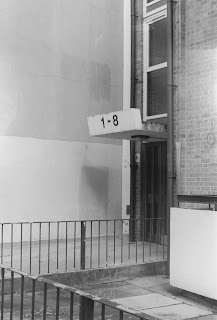 |
| 1-8, London, March 2019 |
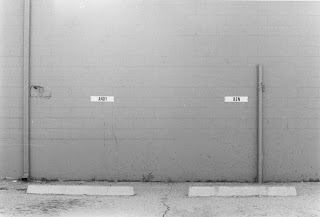 |
| Andy and Ben, Kansas City, April 2019 |
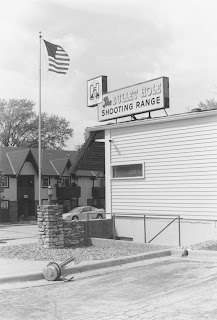 |
| The Bullet Hole, Kansas City, April 2019 |
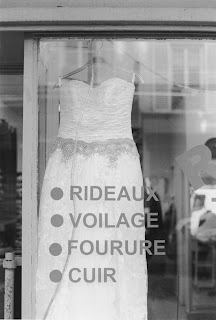 |
| French Bride, Paris, March 2019 |
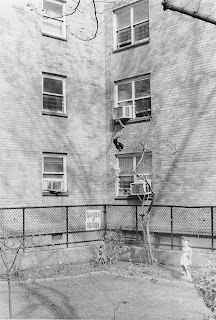 |
| Garden of Beauty, New York, April 2019 |
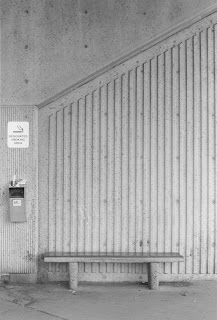 |
| Designated Smoking, Kansas City, April 2019 |
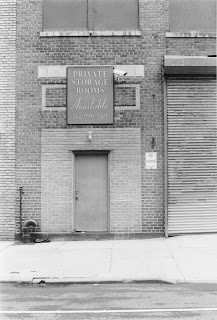 |
| Private Storage, New York, April 2019 |
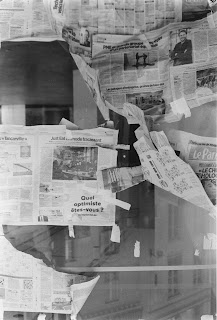 |
| Quel Optimiste, Paris, March 2019 |
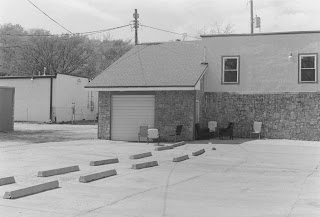 |
| Rosedale Chairs, Kansas City, April 2019 |
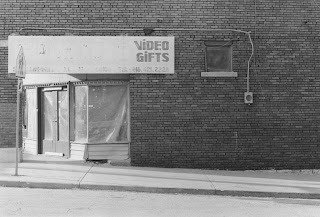 |
| Video Gifts, Kansas City, April 2019 |
I say "stationary indoor tasks" because one of the greatest joys of being a photographer is that there are truly no constraints to photo-taking time, except for light and having a roll of film handy. There are very few moments in the day when I feel like I could not take a single photograph, and it is usually when I am sitting in the office at work. I always try to keep my camera on me, even if I am running to the grocery store at the corner, as we never know when something will urge you to take a photograph. In preparing my final portfolio for last semester, I decided to cut out one of my favorite photographs solely because all others were taken outside.
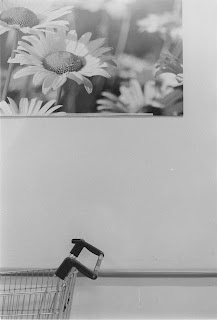 |
| Tesco, London, March 2019 |
This photograph, taken around midnight in a London grocery store truly embodies the possibilities of photography. There is always an endless supply of photo-taking opportunities, and it is our job to keep our cameras on us at all times.
Monday, July 22, 2019
A Day in New Mexico
There are few moments in time as precious as five days spent on the road, traveling through Texas, New Mexico, and Colorado with a couple of your greatest friends. And while these moments were special for all, I, in particular, found great joy in the experience with my camera in hand at all times. On the second day of the road trip, my friends and I drove from Amarillo, Texas to Tucumcari, New Mexico, a 90 minute drive on I-40 W.
Tucumcari, nestled along the mostly desolate Route 66, is a time capsule. Decorated by gas stations, motels, old theaters, saloons, and the occasional souvenir shop, I found the short time we spent in Tucumcari to be a truly magical experience, and perhaps the closest I have ever come to time travel. Our stop in Tucumcari was an equal mix of driving through the few streets in the town and frolicking through parking lots of motels that have since gone out of business, peeking into windows that haven't been washed in ages.
Tucumcari, nestled along the mostly desolate Route 66, is a time capsule. Decorated by gas stations, motels, old theaters, saloons, and the occasional souvenir shop, I found the short time we spent in Tucumcari to be a truly magical experience, and perhaps the closest I have ever come to time travel. Our stop in Tucumcari was an equal mix of driving through the few streets in the town and frolicking through parking lots of motels that have since gone out of business, peeking into windows that haven't been washed in ages.
While we were driving, a man crossed the street, and I was able to capture it. He looked like he was pensively jaywalking to start his shift at Motel Americana, but how can we be so sure?
The photo above was the last photograph I took while stopped in Tucumcari, New Mexico, as my friends were eager to continue our drive to the White Sand Dunes National Park further down the state. Yet my moments spent in that town made me seriously question my place in the world, as Tucumcari still has a population of 4,900, and I live in a city of over 8.6 million. As a visitor, how should I share these photos? Or do I let the few thousand residents of this town live in peace, without a photographer from one of the world's largest cities galavanting around with photos of their stomping grounds? At this moment, I treasure these photographs as a documentation of great times spent with wonderful friends, despite their absence from the images.
Sunday, July 21, 2019
Artist Spotlight: Helen Levitt
Despite the fact that photography is a relatively accessible form of art in the present day, I often find it troubling that there are so few female photographers discussed in the realm of photography that I study, and that we are looking at in this blog. In the last century, while I am sure there has been a multitude of women who tried their hand at photography, Helen Levitt (1913-2009) rose to great prominence.
Described by The New York Times as "a major photographer of the 20th century who caught fleeting moments of surpassing lyricism, mystery and quiet drama on the streets of her native New York," Levitt's body of work truly encapsulates what it meant to walk the streets of New York City during her lifetime. I have selected a few of my favorite photographs that she took, with a 1988 color shot featured at the end.
All of her photographs depict a certain sense of humanity that I would argue can only be captured through the camera lens. Moments of time that will never be replicated, Levitt captured times equally dramatic as they are mundane, setting a great precedent for street photography for all photographers to come.
Described by The New York Times as "a major photographer of the 20th century who caught fleeting moments of surpassing lyricism, mystery and quiet drama on the streets of her native New York," Levitt's body of work truly encapsulates what it meant to walk the streets of New York City during her lifetime. I have selected a few of my favorite photographs that she took, with a 1988 color shot featured at the end.
All of her photographs depict a certain sense of humanity that I would argue can only be captured through the camera lens. Moments of time that will never be replicated, Levitt captured times equally dramatic as they are mundane, setting a great precedent for street photography for all photographers to come.
Monday, July 15, 2019
An Interview With Photographer Emma DiMarco
Although all art is subjective, it seems that the lines of subjectivity versus objectivity become blurred in today's world given the immense amount of media we consume on a daily basis. As we are continually inundated with media on a daily basis, I have come to the slow realization that this mass consumption has led many to believe that photography is an objective art. Those without any knowledge of the medium are quick to judge a good photograph from a bad photograph, why a picture has a low resolution, or why they chose the model and background they did.
Thus, it is rather serendipitous to find a photographer who works not only commercially but also from a fine arts perspective. On this post you will find my interview with photographer Emma DiMarco, a Fordham University alum. I was introduced to her work through a postcard that was printed for her senior exhibition and continues to live on the walls just outside of the Fordham University Lincoln Center darkroom, a place I nearly live in during the school year. I am incredibly fascinated by her ability to seamlessly capture both commercial, studio-based subjects while also honing her eye for everyday photography. As an introduction, here are a few of my favorite photographs that she has taken:
How did you get into photography?
My mom is a photographer, and I always grew up around cameras and photography. We had a darkroom in my basement when I was a kid and I was always so fascinated watching my mom develop and print photographs. I actually thought it was some type of magic when she'd put the paper in the developer and the image would start to appear.
Isn't that one of the best feelings? I'm still obsessed with it. But my mom has always been incredibly supportive and helpful in my growing as a photographer. I always wanted to be just like her, so naturally I picked up a camera one day and never put it down.
Where do you look for inspiration outside of artists?
As a photographer, do you feel a divide in taking pictures of "work" versus personal joy? Or have those two realms merged together for you?
And what are your optimal photo-taking conditions?
Do you have a favorite photo you've taken?
Thus, it is rather serendipitous to find a photographer who works not only commercially but also from a fine arts perspective. On this post you will find my interview with photographer Emma DiMarco, a Fordham University alum. I was introduced to her work through a postcard that was printed for her senior exhibition and continues to live on the walls just outside of the Fordham University Lincoln Center darkroom, a place I nearly live in during the school year. I am incredibly fascinated by her ability to seamlessly capture both commercial, studio-based subjects while also honing her eye for everyday photography. As an introduction, here are a few of my favorite photographs that she has taken:
How did you get into photography?
My mom is a photographer, and I always grew up around cameras and photography. We had a darkroom in my basement when I was a kid and I was always so fascinated watching my mom develop and print photographs. I actually thought it was some type of magic when she'd put the paper in the developer and the image would start to appear.
Isn't that one of the best feelings? I'm still obsessed with it. But my mom has always been incredibly supportive and helpful in my growing as a photographer. I always wanted to be just like her, so naturally I picked up a camera one day and never put it down.
How would you describe your style of photography?
This is a tough one. I think that it is always changing and evolving. I still feel like I haven't really found my voice as an artist and photographer, but like does anybody ever feel like that? I don't know; I'd say its quirky, sometimes weird and usually humorous, although I don't know if most people pick up on the humor in it. I'd like to think it's timeless, that you could look at the image and not know when it was taken. But I really don't know, I have a really hard time talking about my own work!
What photographers, or artists in general, inspire you?
William Eggleston. He is my favorite ever of all time.
But also Petra Collins, Daniel Arnold, Wim Wenders, Maggie Rogers (my style ICON), Bruce Springsteen (and dad rock in general), Lauren Withrow, Sophie Elgort (my boss, she teaches me lots of things and keeps me wanting to shoot), Jimmy Marble, Cass Bird (gay icon AND photographer: a win win) and Amy Lombard.
Where do you look for inspiration outside of artists?
Driving around for sure. Or just wandering around. People are fucking weird and I find it fascinating the way they interact and create their own homes and living spaces. Also Instagram is a big one. I love instagram.
As a photographer, do you feel a divide in taking pictures of "work" versus personal joy? Or have those two realms merged together for you?
For sure. It's something I've struggled with forever. I've always taken senior portraits and they've been so basic, so unlike any of my personal work, because my personal work has always mainly been landscape-ish photos. But lately I've been working on taking portraits for my personal work and trying to merge that style into the stuff I do for clients.
I think that keeping it separate might be a good thing though? I'm not sure. I don't want to ruin how much I enjoy doing my personal projects by trying to profit off of them or make them feel too much like "work".
And what are your optimal photo-taking conditions?
Out and about, ideally in a new space. I have a hard time photographing things that feel too familiar to me. Being confined to a studio is really difficult for me, and feels too forced. I like to be in real life- ideally somewhere in the middle of nowhere.
Analog or digital? And what's your favorite camera to shoot on?
Analog, always! I've shot on the same Canon AE-1 program since I was 14. I love it. Although for work stuff, digital.
Do you have a favorite photo you've taken?
I basically hate every photo I've ever taken. The photos I love forever that I've taken aren't necessarily good images, but photos that are really meaningful to me. I've attached my favorite photo: it's my 4 sisters in my backyard. It was one of the first rolls of film I've ever taken and it just feels really special to me, they're my favorite people and best friends (tacky, I know). And they are just so tiny and cute. It's from 8 years ago.
Be sure to check out more of Emma's work on her personal website, and support your favorite artists, no matter where they are at in their career.
Sunday, July 14, 2019
Revisiting "Elaborating on the Canon AE-1"
Earlier this month, I discussed how the Canon AE-1's Wikipedia page lacks much discourse on its legacy and popularity. In my July 2nd post "Elaborating on the Canon AE-1," I explained how I added information regarding how the Canon AE-1 is one of the most accessible film cameras for amateur photographers, and how this camera has allowed many to experiment with the art on a relatively low budget.
Unfortunately, when checking in on the Wikipedia edits, it appears that my comments were not approved, or were deleted by another user. Perhaps this is due to the lack of numerical data to back up my thoughts.
Unfortunately, when checking in on the Wikipedia edits, it appears that my comments were not approved, or were deleted by another user. Perhaps this is due to the lack of numerical data to back up my thoughts.
Saturday, July 13, 2019
A Bit of Personal Work
After being asked to share some of my personal work, I decided to collect six photographs that were all taken within the same two months of each other. These two months marked travels between Kansas City, New York, London, and Paris, yet I return to the same photographic style throughout. I believe in capturing similar moments between these very different places we are able to uncover the human truth that we are more similar than we are different.
All of the photographs below were captured on a Canon AE-1 with Ilford HP-5 film at 400 ISO. They were then developed in the dark room, and what you are looking at here are scans of prints, indicated by their slightly different coloring variations.
| 468. New York, New York, April 2019 |
| Don's Liquor. Kansas City, Missouri, April 2019 |
 |
| Salvation Army. Roeland Park, Kansas, April 2019 |
| B&W Deli. New York, New York, March 2019 |
| Will Call. Kansas City, Missouri, April 2019 |
| Luxembourg Garden Theatre. Paris, France, March 2019 |
When taking photographs, I try to abide by Henry Wessel's process as I have talked about in a previous post: don't think before taking the photograph. In doing this, I believe I am able to capture pure moments in time, even if there is not any movement involved. In every shot, I am capturing a different time of day, a different place, a different scenario where we interact differently depending on what our environment is. I believe it is important to let these places, despite their mundane nature, shine in their own ways.
Subscribe to:
Posts (Atom)

